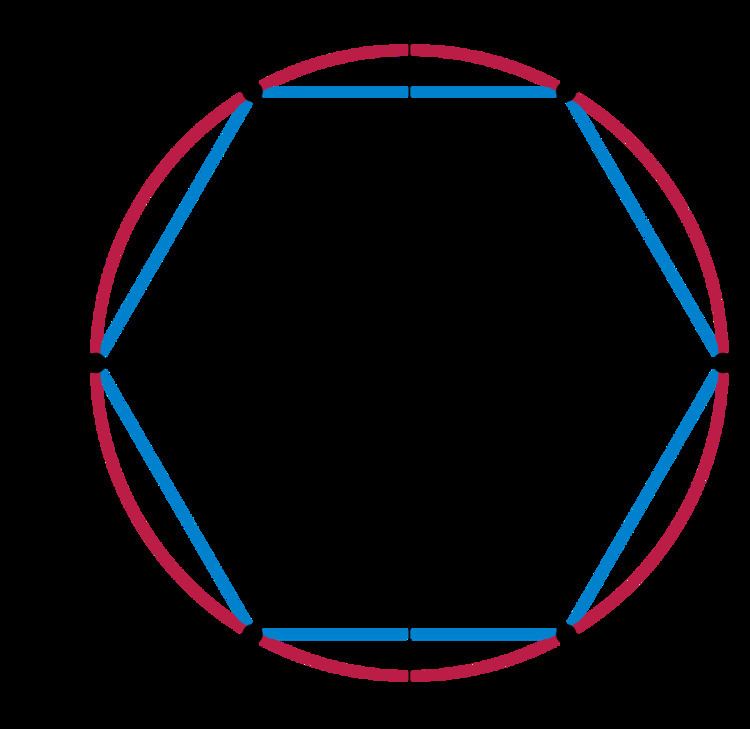In mathematics, the wreath product of group theory is a specialized product of two groups, based on a semidirect product. Wreath products are used in the classification of permutation groups and also provide a way of constructing interesting examples of groups.
Given two groups A and H, there exist two variations of the wreath product: the unrestricted wreath product A Wr H (also written A≀H) and the restricted wreath product A wr H. Given a set Ω with an H-action there exists a generalisation of the wreath product which is denoted by A WrΩ H or A wrΩ H respectively.
The notion generalizes to semigroups and is a central construction in the Krohn-Rhodes structure theory of finite semigroups.
Let A and H be groups and Ω a set with H acting on it. Let K be the direct product
K
≡
∏
ω
∈
Ω
A
ω
of copies of Aω := A indexed by the set Ω. The elements of K can be seen as arbitrary sequences (aω) of elements of A indexed by Ω with component wise multiplication. Then the action of H on Ω extends in a natural way to an action of H on the group K by
h
(
a
ω
)
≡
(
a
h
−
1
ω
)
.
Then the unrestricted wreath product A WrΩ H of A by H is the semidirect product K ⋊ H. The subgroup K of A WrΩ H is called the base of the wreath product.
The restricted wreath product A wrΩ H is constructed in the same way as the unrestricted wreath product except that one uses the direct sum
K
≡
⨁
ω
∈
Ω
A
ω
as the base of the wreath product. In this case the elements of K are sequences (aω) of elements in A indexed by Ω of which all but finitely many aω are the identity element of A.
In the most common case, one takes Ω := H, where H acts in a natural way on itself by left multiplication. In this case, the unrestricted and restricted wreath product may be denoted by A Wr H and A wr H respectively. This is called the regular wreath product.
Notation and conventions
The structure of the wreath product of A by H depends on the H-set Ω and in case Ω is infinite it also depends on whether one uses the restricted or unrestricted wreath product. However, in literature the notation used may be deficient and one needs to pay attention on the circumstances.
In literature A≀ΩH may stand for the unrestricted wreath product A WrΩ H or the restricted wreath product A wrΩ H.
Similarly, A≀H may stand for the unrestricted regular wreath product A Wr H or the restricted regular wreath product A wr H.
In literature the H-set Ω may be omitted from the notation even if Ω≠H.
In the special case that H = Sn is the symmetric group of degree n it is common in the literature to assume that Ω={1,...,n} (with the natural action of Sn) and then omit Ω from the notation. That is, A≀Sn commonly denotes A≀{1,...,n}Sn instead of the regular wreath product A≀SnSn. In the first case the base group is the product of n copies of A, in the latter it is the product of n! copies of A.
Since the finite direct product is the same as the finite direct sum of groups, it follows that the unrestricted A WrΩ H and the restricted wreath product A wrΩ H agree if the H-set Ω is finite. In particular this is true when Ω = H is finite.
A wrΩ H is always a subgroup of A WrΩ H.
Universal Embedding Theorem: If G is an extension of A by H, then there exists a subgroup of the unrestricted wreath product A≀H which is isomorphic to G. This is also known as the Krasner-Kaloujnine embedding theorem. The Krohn-Rhodes theorem involves what is basically the semigroup equivalent of this.
If A, H and Ω are finite, then
If the group A acts on a set Λ then there are two canonical ways to construct sets from Ω and Λ on which A WrΩ H (and therefore also A wrΩ H) can act.
The imprimitive wreath product action on Λ×Ω.
If ((
aω),
h)∈
A Wr
Ω H and (λ,ω')∈Λ×Ω, then
The primitive wreath product action on ΛΩ.
An element in Λ
Ω is a sequence (λ
ω) indexed by the
H-set Ω. Given an element ((
aω),
h) ∈
A Wr
Ω H its operation on (λ
ω)∈Λ
Ω is given by
The Lamplighter group is the restricted wreath product ℤ2≀ℤ.
ℤm≀Sn (Generalized symmetric group).
The base of this wreath product is the
n-fold direct product
of copies of ℤ
m where the action φ :
Sn → Aut(ℤ
mn) of the symmetric group
Sn of degree
n is given by
S2≀Sn (Hyperoctahedral group).
The action of
Sn on {1,...,
n} is as above. Since the symmetric group
S2 of degree 2 is isomorphic to ℤ
2 the hyperoctahedral group is a special case of a generalized symmetric group.
The smallest non-trivial wreath product is ℤ2≀ℤ2, which is the two-dimensional case of the above hyperoctahedral group. It is the symmetry group of the square, also called Dih4, the dihedral group of order 8.
Let p be a prime and let n≥1. Let P be a Sylow p-subgroup of the symmetric group Spn of degree pn. Then P is isomorphic to the iterated regular wreath product Wn = ℤp ≀ ℤp≀...≀ℤp of n copies of ℤp. Here W1 := ℤp and Wk := Wk-1≀ℤp for all k≥2. For instance, the Sylow 2-subgroup of S4 is the above ℤ2≀ℤ2 group.
The Rubik's Cube group is a subgroup of index 12 in the product of wreath products, (ℤ3≀S8) × (ℤ2≀S12), the factors corresponding to the symmetries of the 8 corners and 12 edges.

